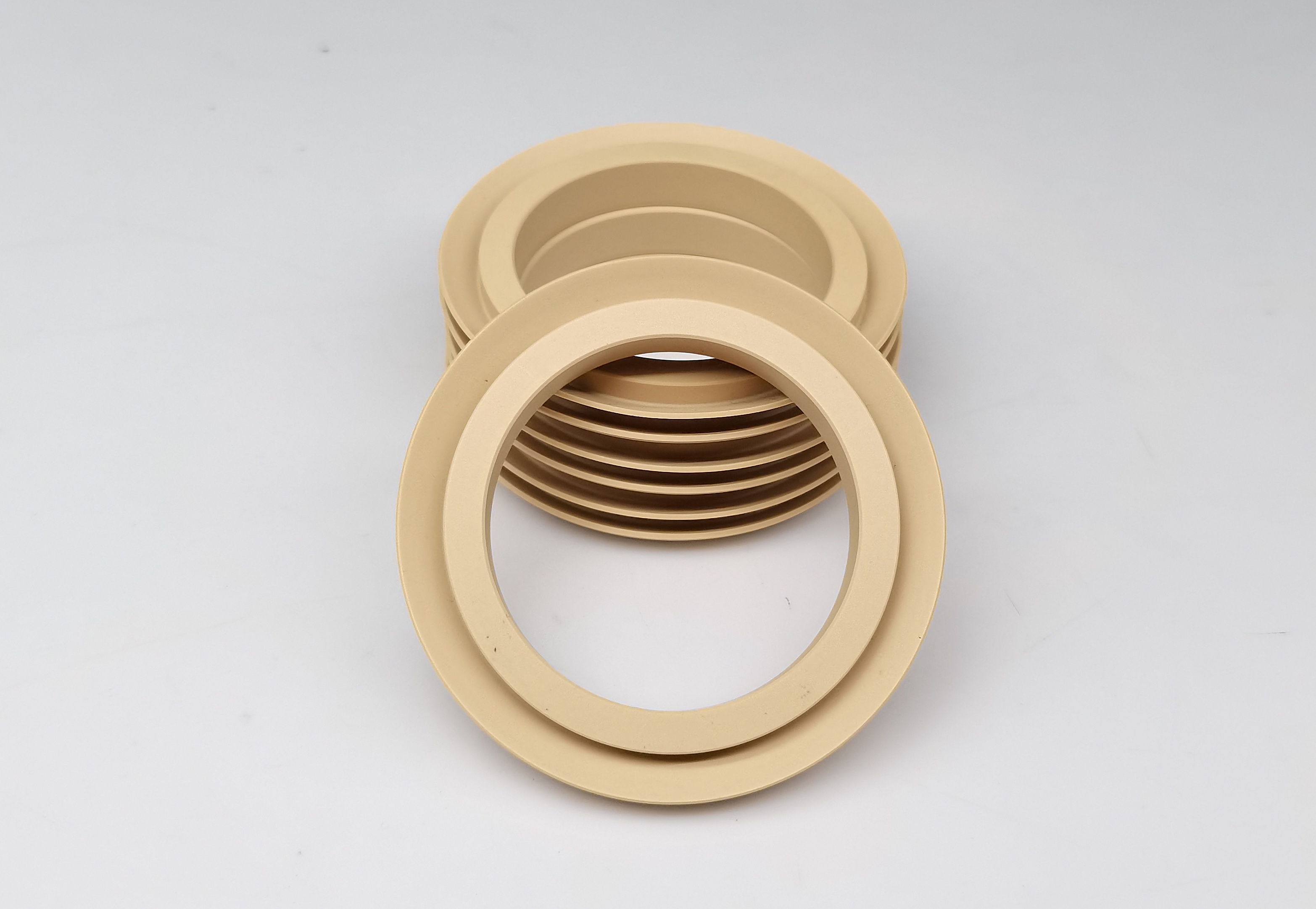Material Design Principles
The CuSn6 bronze-PTFE composite achieves synergistic performance:
| Component | Function | Mechanism |
|---|---|---|
| PTFE Matrix | Chemical inertness / Low friction (μ=0.02–0.1) | Molecular chain slippage |
| Bronze (25–40%) | Thermal conductivity ↑800% | Metallic heat network (k=4.5 W/m·K) |
| Graphite (5%) | Boundary lubrication | Transfer film formation |
Composite Density Formula:
ρcomp=ρPTFE%PTFE+ρBronze%Bronze100
(Optimized density: 2.8–3.2 g/cm³)
Performance Breakthroughs
(ASTM D3702 / ISO 11014 Test Data)
| Parameter | Pure PTFE | 25% Bronze | 40% Bronze |
|---|---|---|---|
| Thermal Conductivity | 0.25 W/m·K | 2.1 | 4.5 |
| PV Limit | 0.5 MPa·m/s | 0.85 | 1.2 |
| CTE (×10⁻⁶/K) | 120 | 45 | 25 |
| Hardness (Shore D) | 55 | 68 | 72 |
| Wear (mg/1000 rev) | 35 | 9 | 5 |
Key Advantages:
- Heat dissipation: 60% shorter thermal path prevents PTFE melting (>150°C)
- Dimensional stability: CTE matches metals (steel CTE=11.5×10⁻⁶/K)
- Wear resistance: Bronze particles bear 60% load
Innovative Structure
Triple-Gradient Sealing System (>20 MPa):
[Primary Seal] ┌─40% Bronze ┐ → Pressure/thermal load
├─25% Gradient┤ → Stress buffering
[Flexible Zone] └─Pure PTFE ┘ → Deformation compensationDynamic Sealing Mechanism:
- Low pressure: PTFE layer compensates gaps (18–22% compression)
- High pressure: Bronze-rich layer resists extrusion (<0.03 mm gap)
- Pulsating loads: Bronze network absorbs vibration (↓80% fretting wear)
Extreme Condition Applications
| Application | Solution | Verification |
|---|---|---|
| Wind turbine pitch cylinders | 30% bronze PTFE step seals | PV=0.9 MPa·m/s at -50°C |
| Injection molding units | Dual-gradient glide rings | >150k cycles @ 230°C |
| Ship rudder systems | Bronze-PTFE + 304SS backing | Zero corrosion @ 35MPa seawater |
Hydraulic System Test Data (35 MPa):
| Metric | NBR Seal | Bronze-PTFE | Improvement |
|---|---|---|---|
| Leakage | 23.5 ml/min | 0.8 | ↓96% |
| Breakaway friction | 4500 N | 1200 | ↓73% |
| Service life | 1,800 h | 12,000 | ↑567% |
Manufacturing Process
Gradient Compaction:
- Powder layering: 40%→25%→0% bronze gradient
- Cold pressing: 30 MPa @ 80°C (prevents PTFE fibrillation)
- Step sintering:
- Stage 1: 300°C×2h (stress relief)
- Stage 2: 380°C×4h (molecular diffusion)
Surface Engineering:
- Plasma etching: 15–20% surface porosity
- Vacuum impregnation: PFAE fluorolube infusion
Selection Guidelines
| Condition | Recommended | Avoid |
|---|---|---|
| Pressure fluctuations | ≥30% bronze + anti-extrusion ring | Unreinforced PTFE |
| >200°C operation | ≥40% bronze layer | <15% bronze content |
| Abrasive media | ≥70 Shore D surface | Untreated surfaces |
| >1 m/s reciprocation | 3–5% graphite addition | Dry running conditions |
Next-Generation R&D:
- Smart seals: Embedded FBG sensors for contact stress monitoring
- Biomimetic structures: Honeycomb bronze skeleton (↓30% weight)
- Nano-coatings: WS₂/MoS₂ multilayer films (μ↓ to 0.01)
Post time: Jul-18-2025

